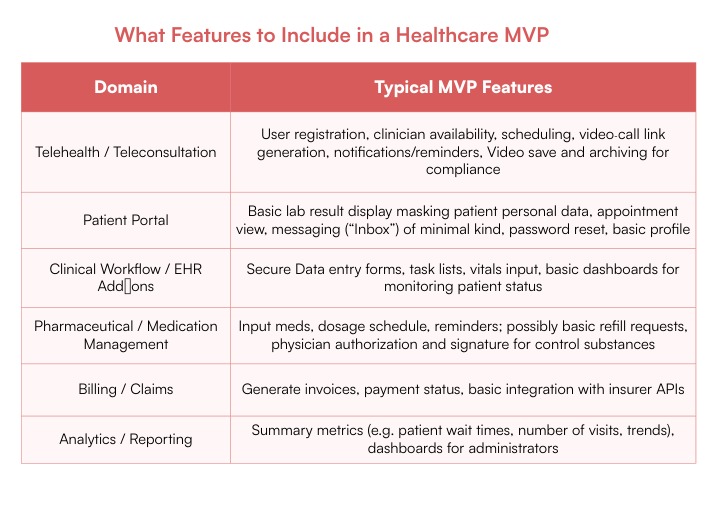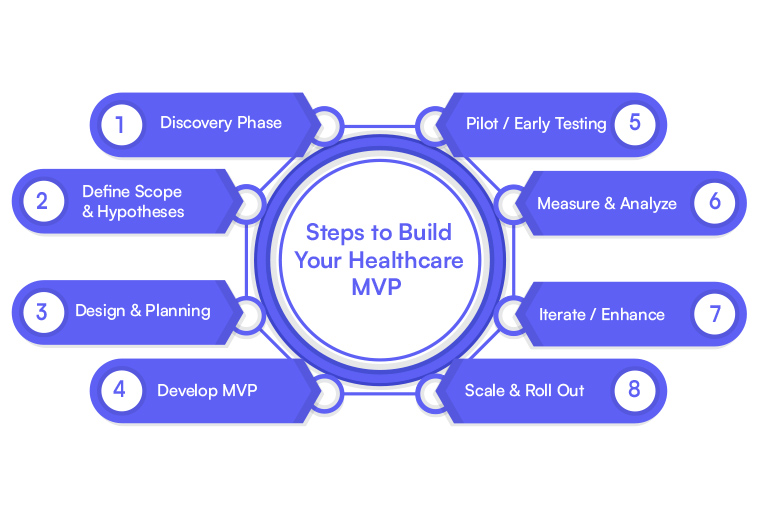In an era of rapid technological change, constrained budgets, regulatory pressures, and high patient expectations, healthcare institutions and startups face a challenging question: where to begin when building digital solutions. A proven strategy is building a Minimum Viable Product (MVP) first. In healthcare, MVP development lets you test core ideas, gain stakeholder feedback, and reduce risk before fully scaling.
In this article, we explore what healthcare MVP development means, why hospitals and HealthTech startups should adopt this approach first, key components of a successful healthcare MVP, common pitfalls, and best practices based on real-world examples.
What Is an MVP in Healthcare?
An MVP (Minimum Viable Product) is a version of a product that includes only the core functionality required to satisfy early adopters, so you can validate assumptions while minimizing investment. In the health domain, this means balancing speed with strict compliance, patient safety, data privacy, usability, and interoperability.
Key characteristics of an MVP for healthcare:
- Core function only: Just enough to deliver the main value proposition (for example, teleconsultation scheduling, or basic patient records review).
- Lean design: Simple workflow, minimal bells and whistles.
- Feedback-oriented: Early involvement of users — doctors, nurses, patients, administrators — to shape the next version.
- Iterative improvement: Using real usage data to guide expansions.
- Compliance built in: Regulatory standards (HIPAA, GDPR, local health authority rules), data security, patient privacy.
Why Hospitals Should Build an MVP First

Hospitals are large, complex organizations. They need digital tools for patient care, data sharing, internal operations, billing, etc. But hospital environments are unique:
- Multiple stakeholders (clinicians, administrators, IT, legal, regulatory).
- Existing legacy systems (EHRs, lab systems, imaging systems).
- Sensitive patient data and regulatory oversight.
- Critical consequences for system failure.
Here are reasons hospitals need healthcare MVP development first:
- Risk Mitigation
Building a full-feature product from Day 1 is expensive and risky. If assumptions about user behavior, interoperability, or regulatory compliance are wrong, the cost is huge. An MVP lets you test assumptions in a controlled way.
- Faster - Time to Value
Hospitals often need immediate improvements — reducing wait times, improving documentation, enhancing patient scheduling, etc. An MVP can deliver some value quickly, instead of waiting years for the “perfect” system.
- Stakeholder Alignment
Healthcare involves doctors, nurses, lab technicians, billing staff, patients, regulators. An MVP serves as something tangible that different groups can interact with, offer feedback on, and align around.
- Budget Constraints
Many hospitals have limited IT budgets. ROI must be demonstrable. With an MVP, you can show measurable improvements before making large investments.
- Regulatory Testing
Compliance, privacy, safety testing: an MVP lets you test how policies and technical architecture map to actual practice, uncover unforeseen compliance risks.
Why HealthTech Startups Must Prioritize MVP Strategy
For HealthTech startups, speed, differentiation, and product-market fit are critical. Here is why MVP healthcare startup approach is indispensable:
- Validate Market Demand
Startup founders often have hypotheses about what users (patients, clinicians) need. The MVP lets you see if there is paid demand (or at least strong interest) before investing heavily.
- Secure Funding
Investors are more comfortable investing in startups that can show early traction, real user feedback, and proof of concept. A well-executed MVP can open doors to seed or Series A funding.
- Iterate Based on Real Data
In healthcare, what people say and what they do can differ. Getting real usage data early helps refine features, usability, and compliance in ways that desk-based planning can’t.
- Lower Costs
Building everything at once is expensive. Building MVP first helps avoid wasted effort on features no one uses, while focusing resources on what truly matters.
- Regulatory and Safety Learning Curve
Because healthcare is tightly regulated, startups often underestimate the complexity of achieving compliance and securing user trust. An MVP gives you early exposure to real regulations (data protection, clinical validation, etc.), minimizing surprises later.
Key Components of a Successful Healthcare MVP Development
To build a solid MVP in the healthcare arena, you need a blend of technical, clinical, legal, and user-experience elements. These components are critical:

Real‑World Examples of Healthcare MVPs
Here are a few real or hypothetical examples that show how healthcare MVP development works in practice.
- Teleconsultation Scheduling MVP
A startup builds an MVP for teleconsultation scheduling: basic patient registration, appointment booking, video link generation, and clinician availability. No fancy AI diagnosis or billing integration yet. It tests with a small clinic. The feedback reveals that many patients want automatic reminders; clinicians want integration with calendars. The startup then adds these.
- Patient Portal for Lab Reports
A hospital builds an MVP that allows patients to view lab reports online, without editing, just the core function. Later, they expand to include interpreting notes, messaging lab technicians, exportable PDF, etc.
- Medication Reminder App
A HealthTech startup builds a very simple app: input medications, get notifications. No social features or gamification at first. Once they see usage, they expand to tracking refill, drug–interaction warnings, etc.
- Hospital Workflow Digitization
A hospital wants to digitize rounds. MVP includes basic patient‐round schedules, doctor checklist, ability to update vitals. Later layers include analytics, AI prediction, dashboards.
Each of these examples shows two truths: first, start small; second, iterate observing real feedback and usage.
Key Challenges in Healthcare MVP Development & How to Overcome Them
Developing MVPs in healthcare is harder than in many other industries. Here are common challenges plus suggested ways to address them:

Best Practices for Healthcare MVP Development
Here are strategies to follow so your MVP healthcare startup or hospital project succeeds.
- Define Clear Hypotheses Before Development
Identify what you believe to be true: e.g., “Clinicians spend 30 minutes per day on manual reports”, “Patients want teleconsults over in‐person if wait time > 2 hours”. Your MVP will test these hypotheses.
- Build with End Users in Mind
Involve doctors, nurses, patients, administrative staff. Hold interviews, shadow existing workflows, observe pain points. This ensures your MVP hits real needs, not just theoretical ones.
- Start with the Simplest Slice of Value
Rather than building the whole product, find one narrow function that solves a core pain. For example, don’t build a full billing and patient information system immediately — pick a single useful workflow.
- Use Agile / Lean Methods
Short development cycles (sprints), frequent check‑ins with stakeholders, regular demos. Be ready to pivot if feedback contradicts assumptions.
- Ensure Security, Privacy, and Compliance from Day One
Don’t treat regulation as an afterthought. Even for MVP, if you collect personal health data, you must address consent, storage, access controls, auditing. Delaying that work causes delays and risks later.
- Measure Carefully
Identify your success metrics: onboarding rate, retention, task completion time, error rate. Use analytics tools, user feedback. Learning what works and what doesn’t is central.
- Plan for Scaling Early
Architectural decisions made during MVP stage influence later costs heavily. Use modular design, clean code, cloud services (if permitted), APIs. This lets you expand features and increase load with less rework.
- Prepare for Regulatory and Clinical Evaluation
Even after the MVP proves useful, real deployment often requires clinical validation, regulatory approval (depending on region), certification as medical device (if relevant). Ensure audit trails and documentation are generated during MVP stage to help.
- Secure Feedback Loops
Use surveys, interviews, usability testing. Listen to both quantitative and qualitative feedback. Sometimes small user frustrations repeat across many users, revealing hidden design flaws.
- Manage Stakeholder Expectations
Be transparent about what the MVP is and what it is not. Hospitals or investors may expect more than the MVP delivers initially. Clarify scope, limitations, risks up front.
What Features to Include in a Healthcare MVP
Which features make up an MVP in healthcare depend on your specific domain (clinical, administrative, telehealth, patient engagement, etc.). Here are features often included in early versions, depending on domain:

The key is: start with the narrowest possible set that addresses a real user need, then verify usage, usability, and impact before adding.
Success Metrics: How Do You Know Your MVP Worked?
To justify moving past MVP to full product, you need data. These success metrics help:
- Adoption Rate:
How many users (clinicians, patients) started using the MVP? How many became regular users?
Suggestion: Track adoption rates over time by setting milestones (e.g., after 1 week, 1 month) to identify early adopter patterns and tailor marketing efforts to expand this base. Offer incentives or support to ease the transition for new users.
- Engagement:
Time spent, number of tasks completed, frequency of usage.
Suggestion: Use in-app analytics tools to track user actions and identify patterns. A/B test different features to see which ones generate the most engagement, and focus on enhancing those.
- Retention:
Are users returning? If drop‐off is high, there may be usability or value issues.
Suggestion: Implement push notifications or email reminders to encourage return visits. Consider adding a feedback loop (e.g., surveys) to pinpoint reasons for drop-off, then refine your user experience based on this data.
- Task Efficiency:
Did certain tasks (e.g., booking appointments, updating patient data) take less time than before?
Suggestion: Conduct user testing and observe task flows to see if they align with the MVP’s goals. Collect qualitative feedback on perceived time-saving and refine your workflows accordingly to improve efficiency further.
- Error Rate / Quality:
Any safety or compliance incidents? Usability‐caused errors?
Suggestion: Conduct regular audits and employ error tracking tools to detect and address issues as they arise. Set up clear reporting protocols and create a quick-response team to tackle issues swiftly.
- User Satisfaction:
Feedback surveys, Net Promoter Score (NPS), qualitative interviews.
Suggestion: Make surveys a regular part of the user experience, such as post-interaction or after specific milestones. Consider incentivizing users to participate and offer actionable feedback. Use NPS as a baseline and track changes over time.
- Cost vs Benefit:
Are the costs (development, maintenance, support) justified by benefits like reduced labor time, improved patient experience, reduced errors, better throughput?
Suggestion: Conduct regular cost-benefit analysis to ensure the MVP's development aligns with your business goals. Regularly assess the impact on productivity, and use this data to justify continued investment in the MVP.
- Scalability:
Can the system handle more users/usage without unacceptable degradation?
Suggestion: Perform load testing at various stages of development to ensure your infrastructure can scale. Keep scalability in mind when designing the architecture to ensure the system can grow without major redesigns.
If your metrics show strong signals in these areas, you have justification to expand functionality, integrate more systems, or increase investment. By continuously gathering and analyzing this data, you'll be well-equipped to make informed decisions and prove the viability of your MVP as it evolves into a full product.
Steps to Build Your Healthcare MVP

Here is a step‑by‑step roadmap hospitals or healthtech startups can follow.
Discovery Phase
- Stakeholder interviews (clinicians, administrators, patients).
- Observe workflows, identify pain points.
- Competitive landscape: what tools already exist? What gaps?
Define Scope & Hypotheses
- Identify primary user personas.
- Choose one core problem.
- Define what success looks like (metrics).
Design & Planning
- Sketch wireframes / mockups.
- Plan data architecture (including privacy, access, storage).
- Plan minimal technical stack.
Develop MVP
- Use agile sprints, deliver small increments.
- Build core functionality first.
- Include security, authentication, basic compliance features.
Pilot / Early Testing
- Deploy in a limited setting.
- Observe usage, collect feedback.
- Monitor for bugs, usability issues, safety risks.
Measure & Analyze
- Compare performance against success metrics.
- Gather qualitative feedback.
- Identify what works, what doesn’t.
Iterate / Enhance
- Refine UI, add or remove features.
- Improve reliability, performance.
- Integrate with other systems as needed.
Scale & Roll Out
- Broaden user base.
- Add advanced features (analytics, AI, advanced integrations).
- Ensure full regulatory compliance, data safeguards, clinical validation.
The Business Case: ROI of Healthcare MVP Development
From the cost side and benefit side, here’s how healthcare MVP development can deliver strong return.
Cost Savings:
- Less wasted dev time building features nobody uses.
- Early detection of design flaws or regulatory oversights reduces rework.
- Smaller initial infrastructure costs.
- Reduced risk of full‐scale failure.
Benefit Gains:
- Faster user adoption, because product matches user needs.
- Ability to adapt to changing regulations or market conditions.
- Building trust with users early: patients and clinicians see something tangible.
- Easier fundraising or securing internal investment once there is evidence of value.
Example Financial Metrics:
- If an MVP reduces clinicians’ documentation time by 25%, hospital may see labor cost savings.
- If patient wait times drop, the hospital may handle more patients or reduce penalties.
- Improved patient satisfaction can reduce patient leakage and increase retention.
Common Mistakes to Avoid
To get full benefit from MVP healthcare startup or hospital MVP projects, avoid these pitfalls:
- Overloading the MVP with Features
Trying to include too many "nice‑to‑have" features dilutes focus, delays delivery, increases cost.
- Underestimating Regulatory & Legal Complexity
Assuming compliance is easy can lead to unexpected delays, costs, or legal risks.
- Skipping User Feedback
Building in isolation leads to products that don’t match real workflows or user preferences.
- Ignoring Data Privacy and Security
Weak protections or unclear consent degrade trust; may incur legal penalties.
- Poor Scalability Planning
Code or system architectures built hastily may choke under real world load, or be hard to maintain.
- Lack of Clear Metrics
Deploying an MVP without defining success metrics means you can’t tell if it’s working.
- Neglecting UX & Usability
If the product is hard or unpleasant to use, adoption will stall, or worse — misuse may lead to errors.
What Makes Healthcare MVP Development Unique vs Other Industries
Healthcare MVPs differ in important ways from MVPs in, say, e‑commerce or simple consumer apps:
- Higher stakes: patient safety, medical outcomes, legal liability.
- Strict regulations and compliance requirements: HIPAA, GDPR, medical device regulations, local country health laws.
- Complex existing infrastructure: EHRs, labs, pharmacies, imaging systems — must integrate or coexist.
- Multiple user types: clinicians, patients, administrators, payors — all with different roles and needs.
- Need for clinical validation: medical accuracy, harm prevention, peer reviews may be required.
Because of these, MVPs in healthcare must plan more carefully around safety, compliance, and usability than many other sectors.
How Cabot Technology Solutions Approaches Healthcare MVP Development
At Cabot Technology Solutions, we take pride in our expertise in helping hospitals and HealthTech startups plan and build MVPs. Here’s how we do it:
- Deep Discovery and Research
We begin with stakeholder interviews and field observation. We map user journeys and identify the most painful workflows.
- Define MVP with Clear Hypotheses & Success Metrics
We help clients define exactly what the MVP will test, and what metrics will show success (e.g. time saved, error reduction, satisfaction).
- Design with Compliance & Security from Ground Up
Our design ensures privacy, consent, encryption, audit trails. UX design is informed by real healthcare user requirements.
- Agile & Modular Development
We build in sprints. We choose technology stacks that allow modularity — making integration or scaling easier later.
- Pilot & Feedback Integration
We test MVP in small settings, collect usage data, adjust UI, feature set, workflows based on both qualitative and quantitative feedback.
- Support for Scaling Up
Once the MVP meets success thresholds, we help clients expand, integrate with EHRs or other systems, obtain regulatory approvals, and deploy to wider user groups.
Summary
Health systems and startups that prioritize MVP development reap early benefits: less waste, faster insights, stronger alignment among stakeholders, and better chances for sustainable success. Hospitals benefit by reducing risk and gaining measurable improvements quickly; HealthTech startups benefit by validating value, gaining user trust, and attracting investment.
If you are planning a healthcare project — whether it’s a new app, workflow tool, telehealth platform, or anything in between — starting with an MVP is not optional; it’s fundamental. Get the core right, involve the users, build with compliance and data safety in mind, measure continuously, and iterate. The result is a product that solves real problems, scales well, and survives regulatory scrutiny.

